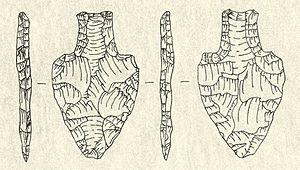Lithic stage facts for kids
The Lithic stage was the very first period when humans lived in the Americas. This time came right after the last Ice Age, as hunters and gatherers moved across the continents.
This period gets its name from the first stone tools people made. These tools were often chipped from stone. Another name for this time is the Paleo-Indian period, which means roughly the same thing.
During the Lithic stage, people used two main types of stone tools. Some were simple, made by hitting stones together to create sharp flakes. Others were more advanced, like special spear points. These points were shaped carefully and often had grooves, or "flutes," on them. In South America, people made unique "fluted fishtail" tools. These tools show how early people adapted to different places.
The Lithic stage ended at different times in different places. It began to fade as people started using textiles (like woven cloth) and pottery. Also, people slowly began to switch from being hunters and gatherers to farming and raising domesticated animals. This change happened around 5,000 to 3,000 BCE in many areas.
After the Lithic stage came the Archaic stage. In some parts of Peru, like the Norte Chico civilization, this period was called the Cotton Pre-Ceramic. This is because cotton was very important for their economy and power, starting around 3,200 BCE.
Archaeologist Alex Krieger has found hundreds of sites with simple, chipped stone tools. The strongest proof for the Lithic stage comes from South America. Here, very old tools have been found, some dating back more than 20,000 years!
In North America, the Lithic stage is also known as the Paleo-Indian period. This period is often split into smaller parts, like the Early Lithic stage and Middle Lithic stage. Famous groups from this time include the Clovis culture and Folsom tradition peoples. The Lithic stage was later followed by the Archaic stage.
Key Moments in the Lithic Stage
- Further information: Timeline of North American prehistory
- 12,340–10,800 BCE: People left a stone-lined fireplace and ancient waste in Paisley Caves, Oregon.
- 10,200 BCE: A bison skull was painted with a red zigzag in what is now Oklahoma. This is the oldest known painted object in North America.
- 9500 BCE: Huge ice sheets, called the Cordilleran and Laurentide Ice Sheets, melted enough to open a path through North America. This path was along the Rocky Mountains.
- 9500 BCE: People in New Mexico made early Clovis spear points, knives, and skin scrapers from rock.
- 9250–8950 BCE: The Clovis culture peoples in the Plains and Southwest made thin, grooved Clovis points. These were special spear points made by chipping stone on both sides.
- 9001 BCE: Evidence of human activity was found on the Channel Islands of California and in coastal Peru.
- 9000 BCE: More signs of people were found on the Channel Islands off California.
- 9000 BCE: Human settlers arrived in the Great Basin, which was cool and wet then.
- 9000–8900 BCE: The Folsom culture in New Mexico left behind bison bones and stone spear points.
- 8700 BCE: Human settlements reached the Northwestern Plateau region.
- 8000 BCE: The last Ice Age ended. This caused sea levels to rise and flood the Beringia land bridge. This closed the main way people migrated from Siberia.
- 8000 BCE: Enough rain fell in the American Southwest to support large animals like mammoths, mastodons, and bison. These animals soon became extinct.
- 8000 BCE: Native Americans had left traces of their presence in every part of the Americas where people could live. This included the American Northeast, the Pacific Northwest, and a cave on Prince of Wales Island in Alaska. They might have been following game animals.
- Further information: Archaic Period (Americas)
- 7500 BCE: Early basket-making began.
- 7560–7370 BCE: Kennewick Man died near the Columbia River in Washington State. His remains were one of the most complete early Native American skeletons found.
- 7000 BCE: As the climate warmed, people in the Northeast started to rely more on deer, nuts, and wild grains.
- 7000 BCE: Native Americans in the Lahontan Basin, Nevada, began to mummify their dead. This showed deep respect for them.
- 6500 BCE–200 CE: The San Dieguito-Pinto tradition and Chihuahua tradition thrived in southern California, the Southwest, and northwestern Mexico.
- 6000 BCE: Ancestors of Penutian-speaking peoples settled in the Northwestern Plateau.
- 6000 BCE: Nomadic hunting groups roamed Subarctic Alaska. They followed herds of caribou and other game animals.
- 6000 BCE: Aleut people began to arrive in the Aleutian Islands.
- 5700 BCE: The huge eruption of Mount Mazama happened in Oregon.
- 5500 BCE–500 CE: The Oshara Tradition, a Southwestern Archaic group, appeared in north-central New Mexico, the San Juan Basin, the Rio Grande Valley, southern Colorado, and southeastern Utah.
- Natives of the Northwestern Plateau began to rely on salmon runs for food.
- 5000 BCE: Early farming of food crops started in Mesoamerica.
- 5000 BCE: Native Americans in the Pacific Northwest, from Alaska to California, developed a fishing economy. Salmon became a main food source.
- 5000 BCE: The Old Copper Culture in the Great Lakes area hammered copper metal into tools and ornaments. These included knives, axes, awls, bracelets, rings, and pendants.


